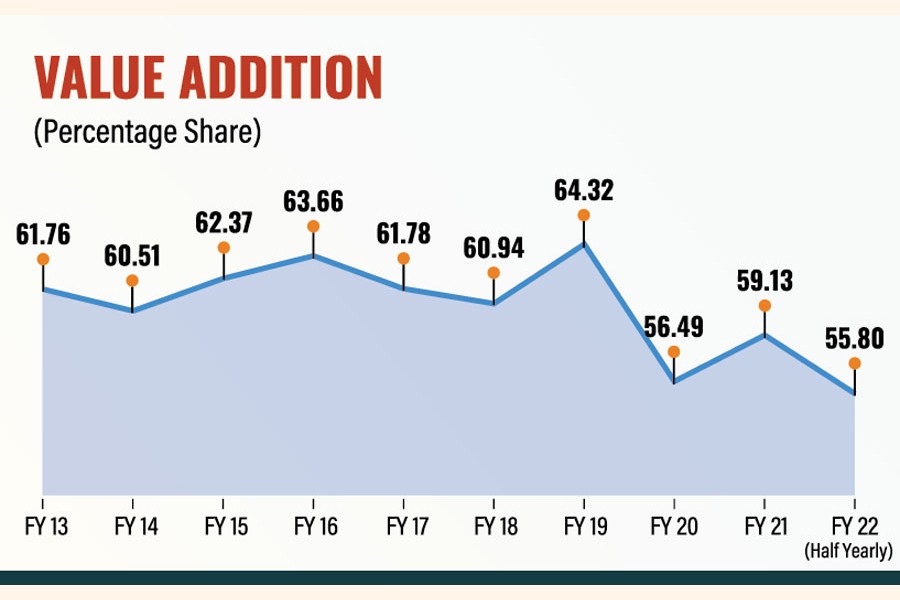
Value addition in the country's ready-made garment (RMG) sector has been fluctuating in recent years. Exporters have mainly blamed the pandemic-induced high prices of raw materials and absence of long-term policy supports for this.
Local RMG items' value addition remained almost static between 60 per cent and 64 per cent from fiscal year (FY) 2012-13 to FY 2018-19, according to the Bangladesh Bank data.
But data analysis showed that it fell to 56.49 per cent in FY 20, and went up to 59.13 per cent in FY 21.
In FY 20, Bangladesh fetched US$27.94 billion from RMG exports, while it imported raw materials worth $12.26 billion. Thus, the country's net RMG exports stood at $15.67 billion in FY 20, showing a 56.49 per cent value addition.
The percentage further decreased to 55.80 per cent during the first half (H1) of current FY, 2021-22, as net RMG exports stood at $11.10 billion against exports worth $19.90 billion and raw material imports worth $8.79 billion.
The value addition remained lower than the pre-pandemic 64.32 per cent in FY 19, data showed.
The central bank considered the main head value of the components (raw cotton, synthetic/viscose fibre, synthetic/mixed yarn, cotton yarn, textile fabrics, and accessories for garments) instead of only raw materials - brought through back to back L/Cs, according to its latest quarterly report.
Meanwhile, industry insiders said Bangladesh is largely dependent on imported raw materials, such as cotton, petro-chemicals and chemicals, despite being the second largest exporter of RMG.
The value addition of the knitwear sub-sector is higher than the woven segment, as the former sources 80 per cent of its required raw materials from local market, while woven is largely dependent on imported fabrics, they noted.
When asked, Bangladesh Garment Manufacturers and Exporters Association (BGMEA) Vice President Md Shahidullah Azim said prices of raw materials have significantly gone up during the last two years - mainly because of the pandemic.
"Though we have been getting huge volume of work orders, prices of finished products have not increased in line with the high prices of raw materials. The sky-rocketing raw material prices have eaten up our value addition."
Besides, exporters cannot bargain with buyers in the time of receiving orders, as they are not aware of or there is no forecast about future price hike of energy including gas and fuel, Mr Azim opined.
Buyers are aware of external cost hike, but they do not always know about internal changes. The government should change its policies following consultations with major stakeholders concerned, and keep policy supports unchanged for a certain period.
Besides, the global demand for garment items - made of non-cotton or man-made fibres - has been increasing, whereas Bangladesh largely produces cotton-based items, the BGMEA leader noted.
The government's policy support is needed to attract investment in producing man-made fibre-based garments - not only to increase value addition but also to face the post-graduation challenges and remain competitive, he added.
Talking to the FE, Bangladesh Knitwear Manufacturers and Exporters Association (BKMEA) Vice President Fazlee Shamim Ehsan also echoed with the BGMEA leader.
He, however, said they are now producing many high value added items, and because of producing these items, value addition in RMG still remains at the current position.
Otherwise, the value addition rate would have been much lower, as prices of garment items have not increased in line with prices of raw materials.
"Value addition of knit items is higher compared to that of woven," he said, explaining that it is because they mostly manufacture products after total processing (yarn manufacturing, knitting and dying) in the country.
On the other hand, buyers have their own nominations - mostly for fabric sourcing, washing and embroidery from third countries - in case of woven garments, he noted.
According to industry insiders, the woven sub-sector of the country's principal export industry is likely to face strict rules-of-origin (RoO) requirements in its major destinations, including the European Union (EU), after Bangladesh's LDC graduation.
Local clothing producers will need to comply with double-transformation requirements, irrespective of their access to GSP or GSP-plus schemes.
Bangladesh needs to invest a huge amount to develop a backward linkage industry for woven segment - not only to add more value but also to face the post-graduation challenges and ensure competitiveness, they noted.
Both the BGMEA and BKMEA leaders requested the government for providing required policy supports, including cash incentive for non-cotton or man-made fibre production as well as soft loan to attract investment in this regard.
According to the Bangladesh Textile Mills Association (BTMA), local textile millers meet 75-80 per cent of knitters' demand for fabrics, while the percentage is only 35-40 per cent for woven fabrics.
Bangladesh imported 552,859 tonnes of woven fabrics in 2021, up from 490,430 tonnes in 2017, according to the BTMA data.
Munni_fe@yahoo.com
© 2025 - All Rights with The Financial Express
